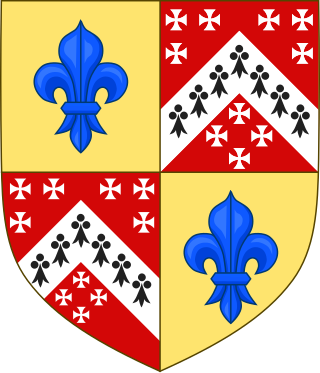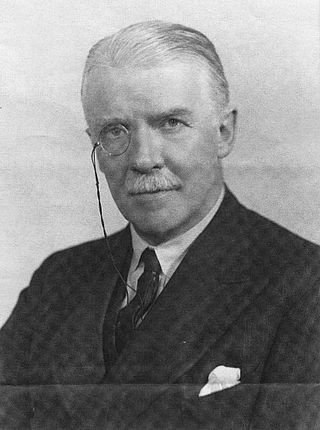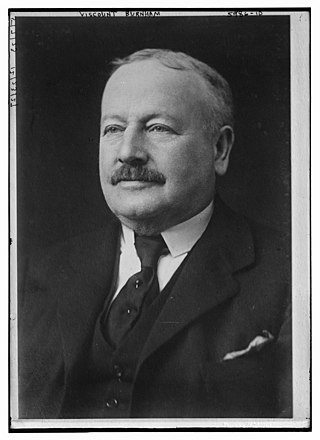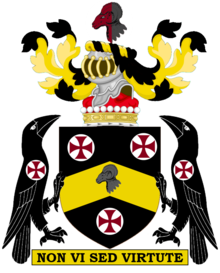
Earl of Sandwich is a noble title in the Peerage of England, held since its creation by the House of Montagu. It is nominally associated with Sandwich, Kent. It was created in 1660 for the prominent naval commander Admiral Sir Edward Montagu. He was made Baron Montagu of St Neots, of St Neots in the County of Huntingdon, and Viscount Hinchingbrooke, at the same time, also in the Peerage of England. The viscountcy is used as the courtesy title by the heir apparent to the earldom. A member of the prominent Montagu family, Lord Sandwich was the son of Sir Sidney Montagu, youngest brother of Henry Montagu, 1st Earl of Manchester, and Edward Montagu, 1st Baron Montagu of Boughton.

Viscount Cobham is a title in the Peerage of Great Britain that was created in 1718. Owing to its special remainder, the title has passed through several families. Since 1889, it has been held by members of the Lyttelton family.

Viscount Chandos, of Aldershot in the County of Southampton, is a title in the Peerage of the United Kingdom and held by a branch of the Lyttelton family. It was created in 1954 for the businessman and public servant Oliver Lyttelton. He was the son of the politician and sportsman Alfred Lyttelton, eighth son of George Lyttelton, 4th Baron Lyttelton, whose eldest son, the 5th Baron Lyttelton, also succeeded his kinsman The 3rd Duke of Buckingham and Chandos as 8th Viscount Cobham in 1889. As of 2017 the title of Viscount Chandos is held by the first Viscount's grandson, the third Viscount, who succeeded his father in 1980. He lost his seat in the House of Lords after the passing of the House of Lords Act of 1999, which removed the automatic right of hereditary peers to sit in the upper chamber of Parliament. However, in 2000 he was given a life peerage as Baron Lyttelton of Aldershot, of Aldershot in the County of Hampshire, and was thus able to return to the House of Lords, where he now sits on the Labour benches. Lord Chandos is also in remainder to the viscountcy of Cobham and its subsidiary titles the barony of Cobham, the barony of Lyttelton, the barony of Westcote and the baronetcy of Frankley.

Marquess of Linlithgow, in the County of Linlithgow or West Lothian, is a title in the Peerage of the United Kingdom. It was created on 23 October 1902 for John Hope, 7th Earl of Hopetoun. The current holder of the title is Adrian Hope.
Earl of Inchcape is a title in the Peerage of the United Kingdom. It was created in 1929 for the Scottish shipping magnate and public servant James Mackay, 1st Viscount Inchcape. He had been created Baron Inchcape, of Strathnaver in the County of Sutherland, in 1911, and Viscount Inchcape, of Strathnaver in the County of Sutherland, in 1924. He was made Viscount Glenapp, of Strathnaver in the County of Sutherland, at the same time as he was given the earldom. These titles are also in the Peerage of the United Kingdom.

Earl of Romney is a title that has been created twice.

Earl of Lonsdale is a title that has been created twice in British history, firstly in the Peerage of Great Britain in 1784, and then in the Peerage of the United Kingdom in 1807, both times for members of the Lowther family.

Earl Howe is a title that has been created twice in British history, for members of the Howe and Curzon-Howe family respectively. The first creation, in the Peerage of Great Britain, was in 1788 for Richard Howe, 4th Viscount Howe, but it became extinct upon his death in 1799. The second creation, in the Peerage of the United Kingdom, was in 1821 for Richard Curzon-Howe, 2nd Viscount Curzon, and it remains extant.

Earl Cowley is a title in the Peerage of the United Kingdom. It was created in 1857 for the diplomat Henry Wellesley, 2nd Baron Cowley. He was Ambassador to France from 1852 to 1867. He was made Viscount Dangan, of Dangan in the County of Meath, at the same time as he was given the earldom. This title is also in the Peerage of the United Kingdom. Lord Cowley was the eldest son of Henry Wellesley, 1st Baron Cowley, who like his son served as Ambassador to France. In 1828 he was created Baron Cowley, of Wellesley in the County of Somerset, in the Peerage of the United Kingdom. A member of the prominent Wellesley family, Cowley was the fifth and youngest son of Garret Wellesley, 1st Earl of Mornington, and the younger brother of Arthur Wellesley, 1st Duke of Wellington, and Richard Wellesley, 1st Marquess Wellesley.

Earl of Lytton, in the County of Derby, is a title in the Peerage of the United Kingdom. It was created in 1880 for the diplomat and poet Robert Bulwer-Lytton, 2nd Baron Lytton. He was Viceroy of India from 1876 to 1880 and British Ambassador to France from 1887 to 1891. He was made Viscount Knebworth, of Knebworth in the County of Hertford, at the same time he was given the earldom, also in the Peerage of the United Kingdom.

Viscount Galway is a title that has been created four times in the Peerage of Ireland. The first creation came in 1628 in favour of Richard Burke, 4th Earl of Clanricarde. He was made Earl of St Albans in the Peerage of England at the same time. The second creation came in the Peerage of Ireland in 1687 in favour of Ulick Bourke. He was made Baron Tyaquin at the same time, also in the Peerage of Ireland. However, both titles became extinct on his early death in 1691. The third creation came in the Peerage of Ireland in 1692 in favour of the French soldier and diplomat Henry de Massue, Marquis de Ruvigny, who was created Baron Portarlington, also in the Peerage of Ireland, at the same time. He was made Earl of Galway in 1697. However, both titles became extinct on his death in 1720.

Viscount Portman, in the County of Somerset, is a title in the Peerage of the United Kingdom. It was created on 28 March 1873, for the former Lord Lieutenant of Somerset and Liberal Member of Parliament Edward Portman, 1st Baron Portman. He had already been created Baron Portman, of Orchard Portman, on 27 January 1837, also in the Peerage of the United Kingdom. His son, the second Viscount, represented Shaftesbury and Dorset in the House of Commons as a Liberal. As of 2014, the titles have been held by one of the latter's great-great-grandsons, the tenth Viscount, since 1999.

Viscount Daventry, of Daventry in the County of Northampton, is a title in the Peerage of the United Kingdom. It was created on 6 May 1943 for Muriel FitzRoy, in honour of her late husband, the Hon. Edward FitzRoy, Speaker of the House of Commons from 1928 until his death in 1943. The first Viscountess was the sister of Frank Douglas-Pennant, 5th Baron Penrhyn, whilst Edward FitzRoy was the second son of Charles FitzRoy, 3rd Baron Southampton, and a male-line descendant of Charles FitzRoy, 2nd Duke of Grafton. Lady Daventry was succeeded by her eldest son, the second Viscount. He was a captain in the Royal Navy. He was succeeded by his nephew, the third Viscount. His father had assumed the additional surname of Newdegate, which was that of his father-in-law. As of 2017 the title is held by his son, the fourth Viscount, who succeeded in 2000. As a male-line descendant of both the third Baron Southampton and the second Duke of Grafton, he is also in remainder to those peerages.

Baron Burnham, of Hall Barn in the Parish of Beaconsfield in the County of Buckingham, is a title in the Peerage of the United Kingdom. It was created on 31 July 1903 for the influential newspaper magnate Sir Edward Levy-Lawson, 1st Baronet, owner of The Daily Telegraph. He had already been created a Baronet, of Hall Barn in The Parish of Beaconsfield in the County of Buckingham and of Peterborough Court in the City of London, in the Baronetage of the United Kingdom on 13 October 1892. Levy-Lawson was the son of Joseph Moses Levy, who acquired The Daily Telegraph only months after its founding.

Herwald Ramsbotham, 1st Viscount Soulbury was a British Conservative politician. He served as a government minister between 1931 and 1941 and served as Governor-General of Ceylon between the years 1949 and 1954.

Peter Edward Ramsbotham, 3rd Viscount Soulbury was a British diplomat and colonial administrator.

Harry Lawson Webster Levy-Lawson, 1st Viscount Burnham, was a British newspaper proprietor. He was originally a Liberal politician before joining the Liberal Unionist Party in the late 1890s. He sat in the House of Commons 1885–1892, 1893–1895, 1905–1906 and 1910–1916 when he inherited his barony.
Ramsbotham is a surname. Notable people with the surname include:
James Herwald Ramsbotham, 2nd Viscount Soulbury was the elder son of the Rt Hon Herwald Ramsbotham, 1st Viscount Soulbury, British Conservative politician.

The Lyttelton family is a British aristocratic family. Over time, several members of the Lyttelton family were made knights, baronets and peers. Hereditary titles held by the Lyttelton family include the viscountcies of Cobham and Chandos, as well as the Lyttelton barony and Lyttelton baronetcy. Several other members of the family have also risen to prominence, particularly in the field of cricket.












